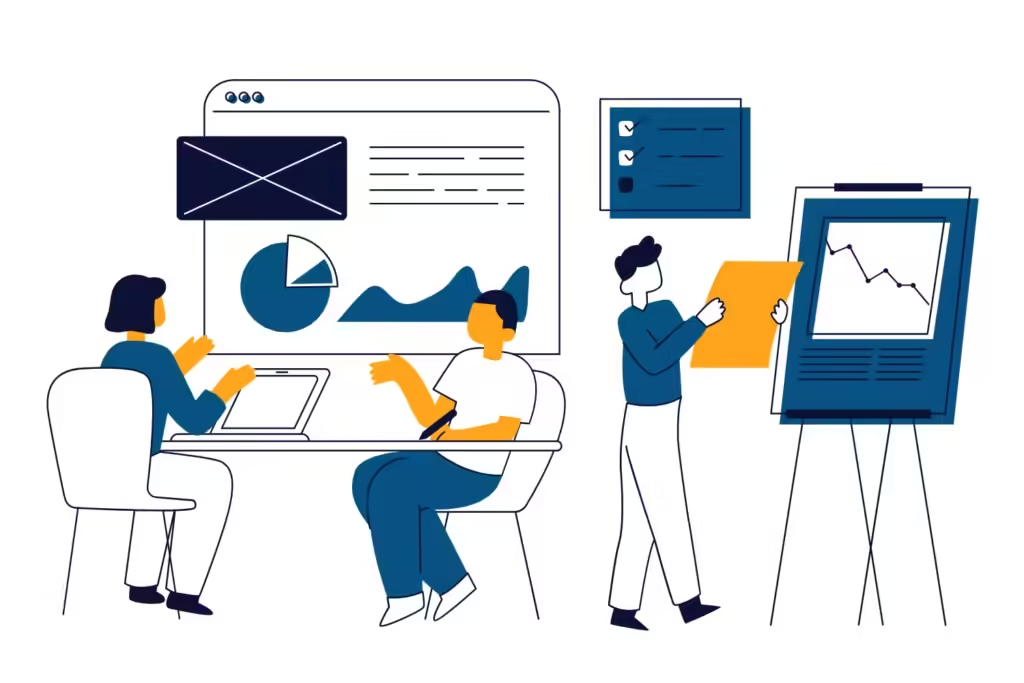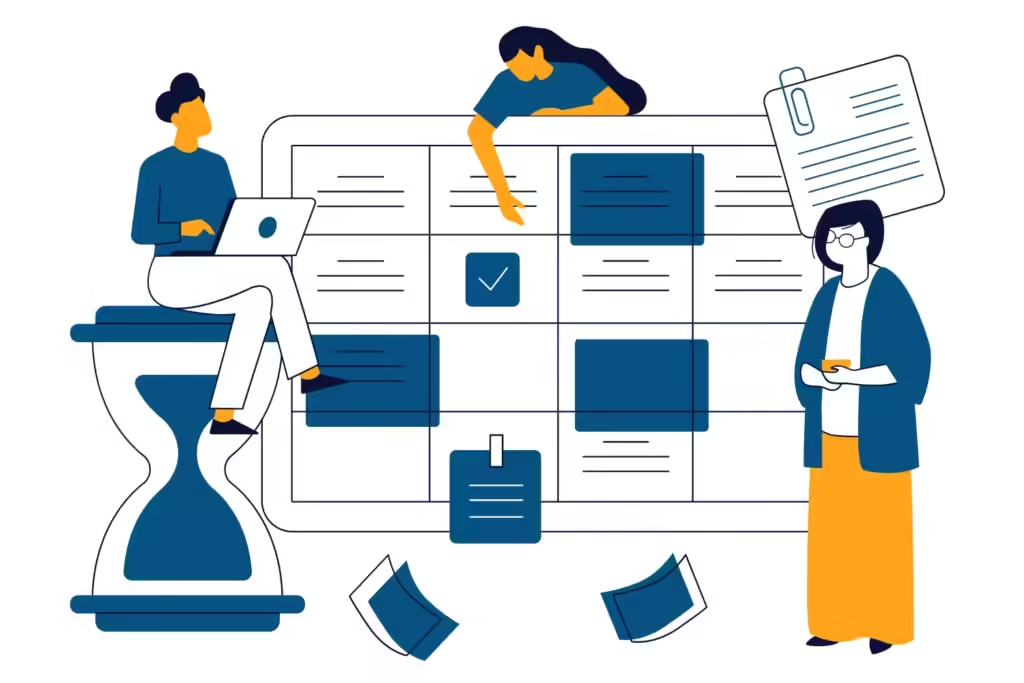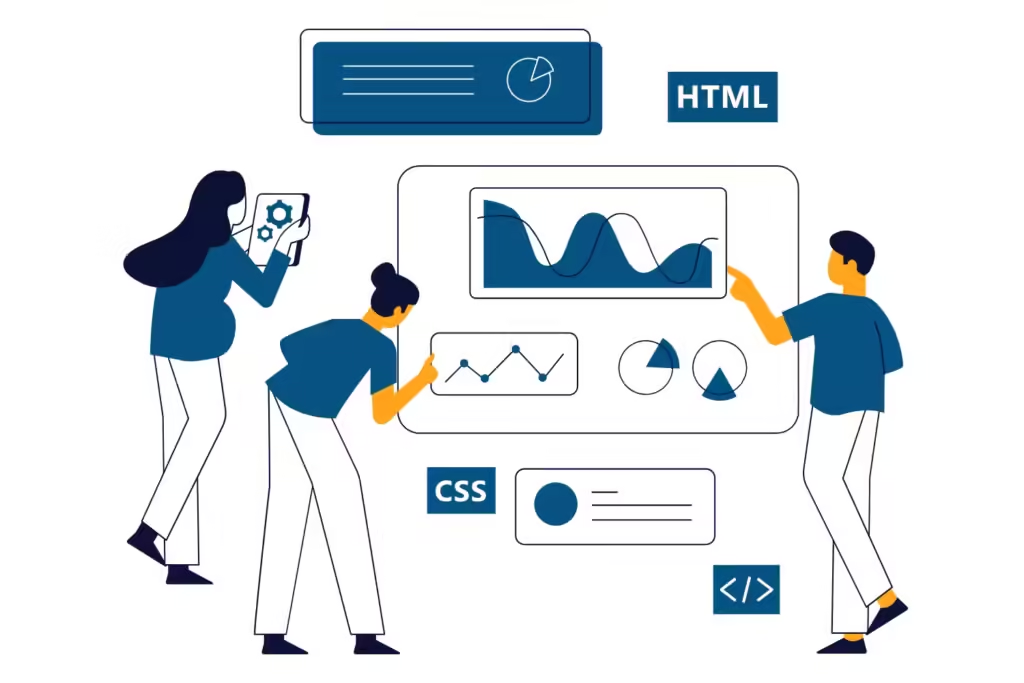Your website is a multi-faceted platform with various moving parts and siloed teams to track continuously. Do you have an organized system to manage ongoing projects and daily tasks simultaneously?
From regular maintenance to complete site redesigns, having streamlined workflows for website project management is essential. It ensures the design and development of your site remains efficient with the time and resources your business invests in.
While certain aspects require collaboration, your web developers, designers, SEO copywriters, and clients should all be on the same page to better deliver quality work.
If they’re constantly disrupted to redo site designs that stray far from the original concept or complete multiple rounds of copy edits that could’ve been consolidated, it can cost you more than necessary. It also increases the chance of mistakes happening due to this lack of focus.
Below is a complete guide to project management for websites to maximize your work efficiency and budget—without overwhelming everyone involved.
Website Project Management for Design & Development: A Complete Guide for Seamless Collaboration & Execution

Website project management should be a separate department or assigned to a specific role outside your dev ops and designers. They’re responsible for their own technical tasks and need proper guidance from a website project manager to execute them efficiently.
Here’s how to ensure you set your web teams up for success in design, development, and everything in between.
Create a Website Project Plan
The first step for completing anything related to your site is creating a clear plan for everyone involved. This includes project management for routine site maintenance, new web builds, and redesigns for internal and external teams.
A website project plan should include the following:
Understanding Your Web Project’s Goals
What are the goals behind your website’s tasks or projects? Whether you’re redesigning, building a new one, or optimizing it for SEO, understanding the reason behind your site’s projects is the foundation of its success.
For example, if you’re creating web content for the sake of doing it, it’s not researched-backed. Your website’s projects should be data-driven to ensure you remain on strategy for your bottom line.
Ask your team the following questions if you need help figuring out your site’s project goals:
- Why are we redesigning this site, and what is this aiming to accomplish?
- Why are we building a new site, and what is this aiming to accomplish?
- What are our top and lowest-performing web pages?
- Which website performance metrics do we want to improve or sustain?
- How do we want our website to support our business goals?
That way, everyone is aligned on the overall mission of the website’s project goals.
Defining Key Web Project Details
Before you begin assigning tasks to your web teams, you must define the key details of how these will be executed and the project scope.
Buffer Budget with All Website Deliverables
First, create a client-approved buffer budget for additional tasks that may pop up or take longer than expected. This budget should include exact deliverables, like the number of redesigned pages or written blogs. Don’t forget to include potential subtasks required, like A/B testing page design concepts and publishing blogs after approval to prevent going out of scope.
Deadline Schedules with Your Preferred Project Management Method

Next, set the deadlines for your website’s tasks and how you want to complete them.
You can create milestones, like building a few web pages at a time and submitting them for client review. Known as agile web development, this project management methodology allows your team to work in short sprints with a few weekly or monthly deliverables at a time.
If you prefer to complete your web projects all at once, choose the waterfall web development approach. However, you must understand the pros and cons of each that best suits your web project’s goals.
Agile web project management is best if you’re on a tight deadline because you gain continuous feedback throughout the design and development process that can be turned around faster with fewer deliverables. Waterfall methodology is best for long-term web projects because it allows your team to work uninterrupted and the extra time to finalize the process.
Website Project Management Template or Software
We can’t stress enough the importance of using website project management platforms like Jira and Trello. Taking advantage of automation saves you time and headaches from manually creating workflows for your site’s projects.
Depending on the application, these may include:
- Pre-built website requests for new page graphics, copy edits, add-on features, etc.
- Interconnected action items that prevent future web tasks from being assigned until the previous one is completed
- Sequenced site design/development steps, like preliminary design, code review, and testing
- Organized web tasks by priority and status of completion
Web project management tools streamline your tasks and teams visually and easily in an automated, centralized platform.
Organize Web Tasks by Phase
Now that your website project plan is finalized, next is organizing the tasks by phase. While project management tools automate this for you, this helps guide your teams throughout the process.
Your site’s tasks should be categorized in the following order:
Website Project Discovery
This discovery phase occurs when you first create your website project plan. This initial step is the ideation of your site’s project. However, it requires careful guidance to prevent your discovery meeting from expanding into unrealistic or disorganized expectations.
Ensure you only include people directly involved with the project, like a lead web developer, site designer, website project manager, and client representative. It prevents you from having too many cooks in the kitchen and promoting over-communication.
You should also prepare questions from your website project plan, like client goals, buffered budget, deliverables, timeline, and project management methodology. That way, there aren’t any surprises that may delay everyone before you start design and development.
Web Design

The site design phase involves multiple people, including web designers, SEO copywriters, and potential clients for approvals. They’re responsible for how the front end of your site will look. It’s especially crucial to organize the design stage of a web project because of the multiple roles you’ll manage.
Set your web design team up for success with the following:
- Submit website examples to your designers for visual layout inspiration, must-have features, etc.
- Provide your web designers with everything they need, including branding guidelines, images, logos, optimized web copy, etc.
- Give platform access to everyone involved to complete design tasks simultaneously across siloed teams
- Schedule design tasks from highest to lowest priority, like your Home page first and Testimonials page later
- Centralize all communications within your project management software for internal teams and update their tasks timely if you have edits from clients after review
You should also standardize core web design processes, including:
- Creating wireframes for web developers to reference when building sitemaps for the site’s structure
- Designing the visual layout of all web pages, including colors, font, visuals, and staging links for client review
- Setting up a content management system (CMS) to host, manage, and upload visuals and text assets for all web pages
- Registering a web domain so your site owns the rights to its name
Keep in mind that your web designers and developers work together to complete site projects. The main difference is that site designers create the visual elements, while web developers build and make them usable.
Web Development
The web development phase primarily involves your dev ops team. They’re responsible for building the back end of your site’s functionality, requiring complex processes that must be executed successfully. While each web build is unique per platform and project, you can streamline their workflows more efficiently.
Standardizing core web development processes should include:
- XML Sitemap Creation: Creating a blueprint of the site’s structure, navigation, information hierarchy, etc.
- Platform Plug-in Installation: Installing popular plug-ins separate from your site platform, like Yoast SEO and WooCommerce.
- SSL (Secure Sockets Layer) Certification: Acquiring the code on your site’s server to create an encrypted connection and secure its data.
- Website Analytics Software Integration: Connecting the software to your site to track its performance.
- Site Code & Tests: Building and testing the site’s various codes and markup languages to ensure proper functionality.
While you can use a website project management tool to automate these processes, it still needs to be properly assigned and scheduled.
Site-Wide Testing
Testing your website is comprehensive, but you don’t need to complicate it more with a set process in place. That way, your dev ops and web design teams ensure they don’t miss any crucial steps.
Create a site-wide testing plan for the following:
- Website accessibility for disabled users per ADA compliance
- User experience (UX) to provide visitors with seamless interaction in all aspects of your site, including minimal pop-ups, balanced white space, easy navigation, etc.
- HTTPS (Hypertext Transfer Protocol Secure) to ensure the HTTP version is redirected for site security
- Page load speed on PageSpeed Insights for mobile and desktop
- Site audits to check for potential issues, like broken links, invalid CSS/HTML, duplicate headings, and missing metadata
Website Launch

Now that your website is ready to go live, your team is in the final phase of design and development.
Include the following in your workflows for a successful site launch:
- Submit sitemaps to Google Search Console for crawling and indexing
- Train internal staff training for website management, like content uploads and performance tracking
- Proofread all web copy to ensure everything is accurate and error-free
Remember, you can always fix minor issues and make design changes once the website is live—so don’t delay the launch for aesthetics and quick fixes!
Post-Launch
Even newly launched websites must be continuously monitored and maintained to ensure they perform as they should. From troubleshooting bugs to optimizing the site for new search engine algorithm updates, your website isn’t a set-it-and-forget-it situation. It’s an ongoing responsibility for your business.
Create a post-launch checklist for your web team, including:
- Scheduling weekly website backups to save your site from accidental data loss
- Checking conversion paths for proper functionality on forms, page displays, etc.
- Cross-promoting the website on social media
- Fixing bugs when necessary
Make Your Site’s Projects Smooth Sailing with a Website Project Manager
As you can see, project management for website design and development is time-consuming and can get complex, even with automated platforms. Let a website project manager do the heavy lifting for you.
At Reach Marketing Pro, we have extensive experience in all aspects of web project management, including site design, development, and maintenance. We’re a full-service digital agency equipped to handle all aspects of your site with our in-house web developers, web designers, graphic designers, SEO copywriters—and, of course, project managers.
That way, you can focus on what you do best—managing your business and being an expert in your trade.
Ready to optimize your website’s workflows and better support your bottom line?
Learn more about our website management services or contact us to make your site’s projects smoother sailing today!

